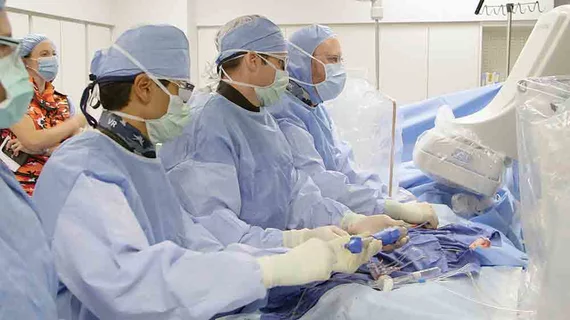Registry analysis finds link between TAVR volume, mortality
With CMS just months away from an updated national coverage determination for transcatheter aortic valve replacement (TAVR), a new analysis in the New England Journal of Medicine suggests the relationship between procedural volume and TAVR outcomes remains important in the United States.
The study included 96,256 patients who underwent transfemoral TAVR at more than 550 U.S. hospitals participating in the Transcatheter Valve Therapy registry from 2015 through 2017. Adjusted 30-day mortality was 3.19% at hospitals in the lowest quartile of volume and 2.66% at those in the highest quartile—a relative difference of 21%.
Put another way, hospitals performing an average of 143 TAVRs each year had a relative mortality reduction of 19.45% compared to those performing 27 procedures annually, based on statistical curves which modeled the relationship between procedural volume and outcomes.
“Advancements in delivery-system size, valve design, national experience, and expansion of TAVR to intermediate-risk patients might be expected to blunt or eliminate any volume-outcome relationship,” wrote lead author Sreekanth Vemulapalli, MD, of Duke University Hospital in Durham, North Carolina, and colleagues. “In addition, low-volume and new TAVR programs may especially benefit from extensive industry support in planning and performing TAVR.
“Yet in this comprehensive study, the absolute change in risk-adjusted mortality across the continuous spectrum of hospital procedural volume was significant and corresponded to a clinically relevant relative difference in mortality between the lowest and highest annualized procedural volume.”
The results appear to agree at least in part with CMS’ recently proposed update to the national coverage policy for TAVR, which required specific procedural volumes to be met for hospitals to begin and maintain a TAVR program. A 30-day public comment period on the proposal is ongoing, and a final decision is expected within 60 days of that comment period ending.
Vemulapalli et al. also found individual operators’ procedural volumes were tied to mortality. The relative difference in adjusted mortality was 24.25% for a physician performing 70 procedures versus 11 procedures annually, but only 200 of the nearly 3,000 operators in the registry performed 75 TAVRs each year. Median annual procedure volumes by hospital and operator were 54 and 27, respectively.
Operators in the highest-volume quartile achieved a 30-day adjusted mortality rate of 2.84% while the same measure was 3.54% among the lowest-volume physicians.
In sensitivity analyses, the authors found the volume-outcome relationship held steady for hospitals even after data was excluded on centers’ first six and 12 months of TAVR experience.
“This finding suggests that the volume-mortality association is not simply related to operator learning or reasonable hospital start-up time,” they wrote. “A recent analysis by Wassef et al. of international sites showed that both learning curve and annual case volume affect TAVR outcomes.”
Vemulapalli and co-authors noted their adjusted models didn’t incorporate social factors or frailty, which may have impacted patient death rates. They also found that hospitals with lower procedural volumes were more likely to be rural and treat a higher percentage of black and Hispanic patients—two results that highlight the potential problem of limiting patients’ access to TAVR if the procedure is limited only to high-volume centers, which tend to be clustered in urban areas.
Achieving the ideal balance between patient access and procedural quality is top of mind for both cardiologists and CMS as the new volume thresholds are developed.

